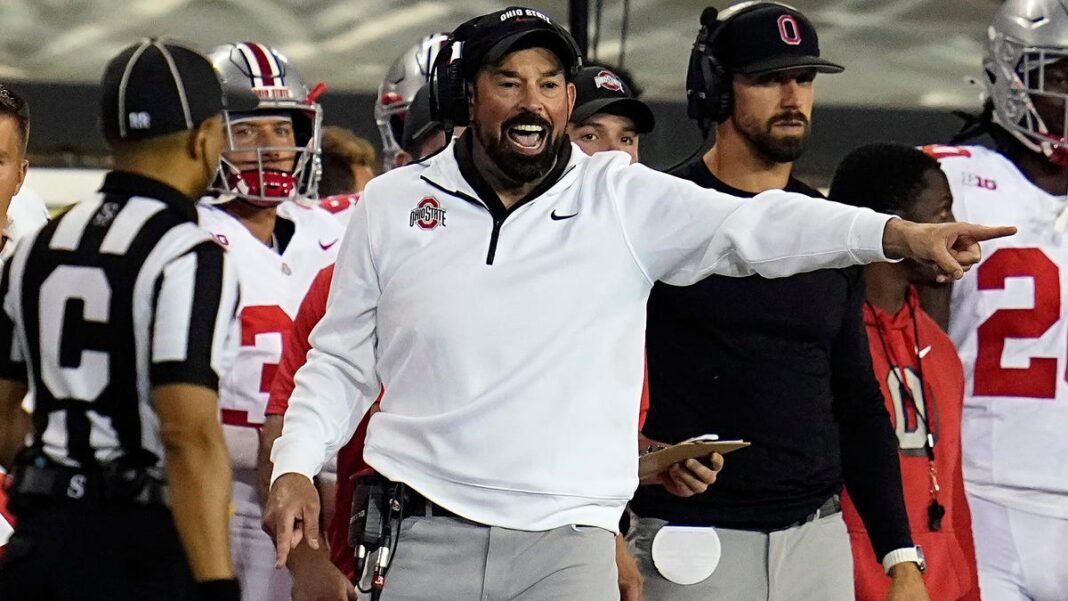Ryan Day Faces Critical Challenge in Ohio State-Michigan Rivalry
This moment was always the focus.
It’s not about an uncertain October game that could be irrelevant by December.
It’s not about another November opponent who might seem promising or an October team that barely managed anything against Ohio State.
This season’s storyline for Ohio State and Coach Ryan Day revolves entirely around Michigan. Positions—along with the escalating financial competition in NIL (Name, Image, Likeness)—hang in the balance.
“All paths lead to this,” Day states. “Every action, every choice we make is aimed at this game.”
Day has tried everything to end a three-game loss streak to Michigan, seeking to revive a rivalry that was long dominated by Ohio State, with the Wolverines only triumphing against an interim Buckeyes coach since 2004.
He dismissed a defensive coordinator, let go of a quarterback, and brought in a prestigious Power Four conference coach as offensive coordinator to reshape his once top-ranked offense—focusing on enhancing “toughness” and “attitude.”
This offseason, he secured the top-rated running back (Quinshon Judkins) and the leading safety (Caleb Downs) from the transfer portal, outspending others for a new starting quarterback (Will Howard).
All of this aimed not just to defeat Michigan but to emulate the Wolverines’ characteristics.
However, the most captivating part of this fierce rivalry—this contempt between the universities that has included tip-offs to the NCAA (we remember the controversy surrounding Connor Stalions and Jim Tressel)—is that the animosity is only going to intensify in the future.
Now that Michigan has recognized that the key to keeping up with Ohio State is to invest aggressively, the financial stakes are higher than ever in the NIL and player transfer landscape. The Michigan vs. Ohio State matchup is poised to evolve into something akin to the Yankees vs. the Dodgers—without any salary cap restrictions.
As a wise saying goes, the team with the biggest budget recruits the best talent and wins the matches.
Or something close to that.
Last week, Bryce Underwood, the top high school football recruit and among the finest quarterbacks in years, switched his commitment from LSU to Michigan, reportedly signing an NIL deal worth $10-12 million—marking the onset of a financial revolution in Ann Arbor.
Legendary quarterback Tom Brady, a Michigan alumnus, has reportedly stepped in to support Underwood’s transition. Additionally, in September, Barstool Sports’ owner Dave Portnoy expressed his willingness to contribute $3 million to help Michigan “secure a quarterback.”
And indeed, they have secured one. This marks just one of Michigan’s many strategic moves in the NIL realm.
This significant maneuver is a clear message to Ohio State that Michigan, with its extensive and affluent alumni network, will boldly combat the evolving landscape of college football.
Michigan, having tasted national success in 2023, is hungry for more, even with former coach Jim Harbaugh and the Stalions controversy trailing them.
Meanwhile, Ohio State isn’t sitting idle as they also tap into their deep alumni resources, allocating $43 million this season with a singular focus: defeat Michigan and strive for a national title.
This rivalry is only just beginning to heat up.
If you thought it was unusual for a coach to retract play-calling responsibilities from a defensive coordinator three weeks into the season or firing a quarterback due to a single game outcome, or even hiring someone like Chip Kelly to toughen up the squad, you haven’t been following just how intense things became at Michigan last year.
Once you decide to defy the NCAA and face complications from dual investigations involving your head coach, you’ve truly embraced the “win at any cost” mentality.
What’s an additional $40 million annually, give or take, to keep battling?
This rivalry has everything at stake. Ultimately, it really has always revolved around this crucial moment.
The team with the biggest budget retains the best players and prevails in The Game.
This will unquestionably characterize the ongoing relationship between Michigan and Ohio State in the new era.

